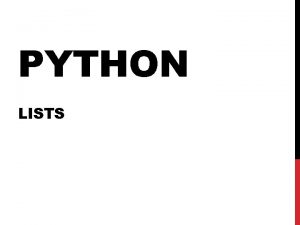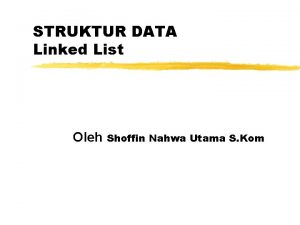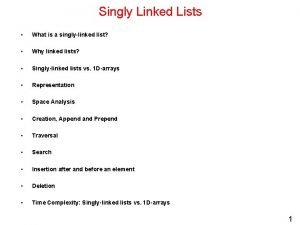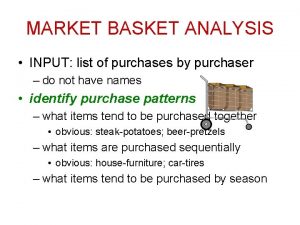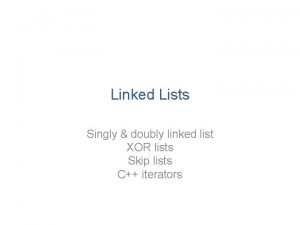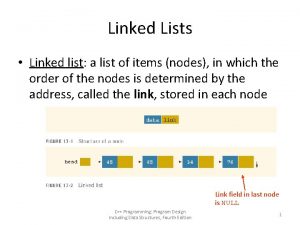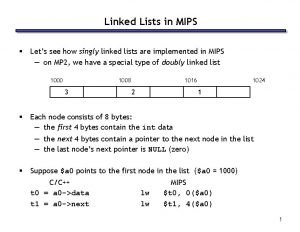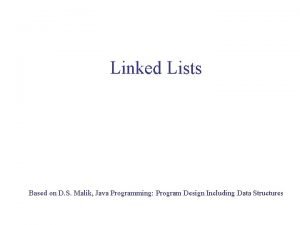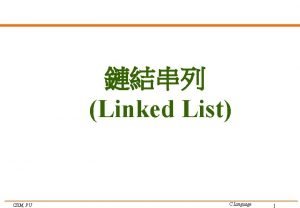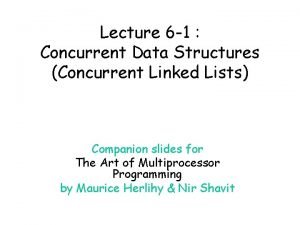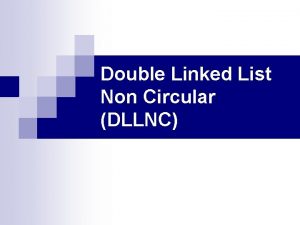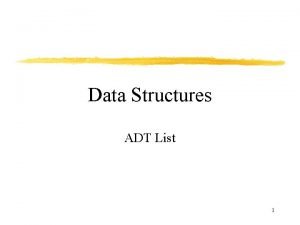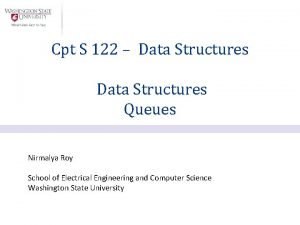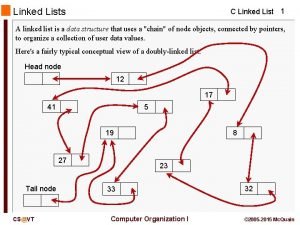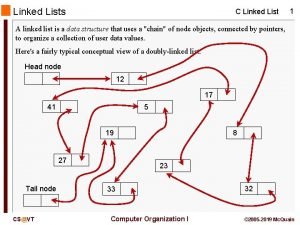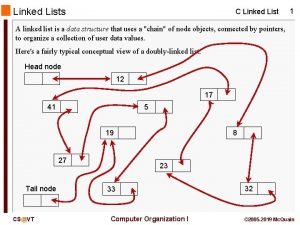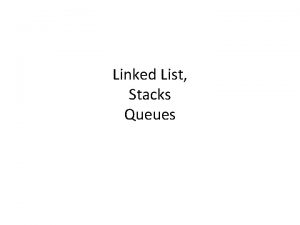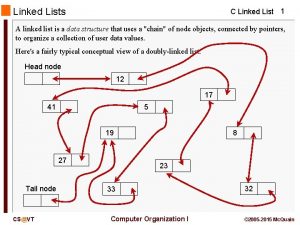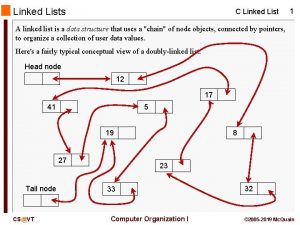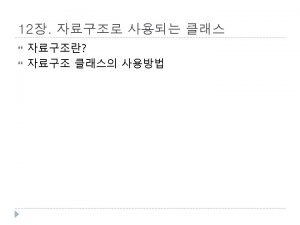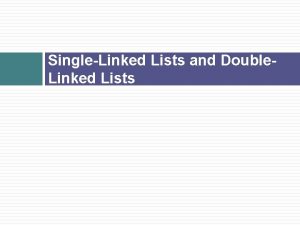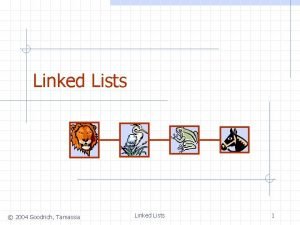Linked List outline Why linked lists Linked lists


























- Slides: 26

Linked List outline • • • Why linked lists Linked lists Representation of Linked lists in memory Traversing a linked lists Basic operations of linked lists – Insert, find, delete, print, etc. • Variations of linked lists – Circular linked lists – Doubly linked lists

Why linked lists • Disadvantages of arrays as storage data structures: – slow insertion in ordered array – Fixed size • Linked lists solve some of these problems • Linked lists are general purpose storage data structures.

Disadvantages of Arrays 1. The size of the array is fixed. – In case of dynamically resizing the array from size S to 2 S, we need 3 S units of available memory. – Programmers allocate arrays which seem "large enough” This strategy has two disadvantages: (a) most of the time there are just 20% or 30% elements in the array and 70% of the space in the array really is wasted. (b) If the program ever needs to process more than the declared size, the code breaks. 2. Inserting (and deleting) elements into the middle of the array is potentially expensive because existing elements need to be shifted over to make room CENG 213 Data Structures 3

Linked lists • Linked lists are appropriate when the number of data elements to be represented in the data structure at once is unpredictable. • Linked lists are dynamic, so the length of a list can increase or decrease as necessary. • Each node does not necessarily follow the previous one physically in the memory. • Linked lists can be maintained in sorted order by inserting or deleting an element at the proper point in the list. CENG 213 Data Structures 4

Linked lists A linked list, or one way list, is a linear collection of data elements, called nodes, where the linear order is given by means of pointers. Each node is divided into two parts: The first part contains the information of the element, and The second part, called the link field or next pointer field, contains the address of the next node in the list. node A data pointer struct node { char data; struct node *next; };

The pointer of the last node contains a special value, called the NULL pointer. A pointer variable – called START which contains the address of the first node. A special case is the list that has no nodes, such a list is called the null list or empty list and is denoted by the null pointer in the variable START. Start node Data Next Linked list with 3 nodes node Data

linked lists • A linked list organizes a collection of data items (elements ) such that elements can easily be added to and deleted from any position in the list. • Only references To next elements are updated in insertion and deletion operations. • There is no need to copy or move large blocks of data to facilitate insertion and deletion of elements. • Lists grow dynamically.

Creation of linked list printf("enter data: "); scanf("%d", &nn->data); #include<stdio. h> struct node { int data; struct node *next; }; a=nn->data; if(start==NULL) //checking if List is empty { nn->next=NULL; start=nn; } else { nn->next=start; start=nn; } printf("%d succ. insertedn", a); return; struct node *start; void main() { struct node *nn; int a; nn=(struct node *) malloc(sizeof(struct node)); }

Traversing a linked lists LIST be a linked list in memory stored in linear arrays INFO and LINK with START pointing to the first element and NULL indicating the end of LIST. We want to traverse LIST in order to process each node exactly once. Pointer variable PTR points to the node that is currently being processed. LINK[PTR] points to the next node to be processed. PTR : =LINK[PTR] PTR Fig : PTR : = LINK[PTR] START INFO LINK X

Traversing a linked lists For printing the information at each node of a linked list, must traverse the list. Algorithm 5. 1 : PRINT(INFO, LINK, START) Algorithm Prints the information at each node of the list. 1. Set PTR : =START. 2. Repeat steps 3 and 4 while PTR : ≠ NULL: 3. Write : INFO[PTR]. 4. Set PTR : =LINK[PTR]. 5. Exit.

Finding number of element in a linked lists For Finding the number NUM of elements in a linked list, must traverse the list. Algorithm 5. 1 : COUNT(INFO, LINK, START, NUM) 1. Set NUM: =0. 2. . Set PTR : =START. 3. Repeat steps 4 and 5 while PTR : ≠ NULL: 4. Set NUM : =NUM+1. 5. Set PTR : =LINK[PTR]. 6. Exit.

Traversing a linked lists void display(void) { struct node *temp; if(start==NULL) { printf("sll is emptyn"); return; } printf("elements are: n"); temp=start; while(temp!=NULL) { printf("%dn", temp->data); temp=temp->next; } return; }

Insertion into a linked list • • 1. 2. Node N is to be inserted in to the list between nodes A and B Two pointer fields are changed as follows: The next pointer field of node A now points to the new node N The next pointer field of node N now points to node B, to which node A previously pointed. START Node A START Node B (a) Before insertion Node B Node A (b) After insertion Node N

Inserting a new node • Possible cases of Insert Node 1. 2. 3. 4. Insert into an empty list Insert in front Insert at end Insert in middle

Insertion at the first Steps: • Create a Node • Set the node data Values • Connect the pointers

Insertion Description head 48 17 142 • Follow the previous steps and we get Step 1 Step 2 Step 3 head 93 //

Insertion at the end Steps: • Create a Node • Set the node data Values • Connect the pointers

Insertion Description: head 48 17 142 • Follow the previous steps and we get Step 1 Step 2 Step 3 //

Insertion in the middle Steps: • Create a Node • Set the node data Values • Break pointer connection • Re-connect the pointers

Insertion Description Step 1 Step 3 Step 4 Step 2

Deleting from the top Steps • Break the pointer connection • Re-connect the nodes • Delete the node

Deletion Description head 6 4 17 42 head

Deleting from the end Steps • Break the pointer connection • Set previous node pointer to NULL • Delete the node

Deletion Description head 6 head 4 17 6 4 17 head 42 42

Deleting from the Middle Steps • Set previous Node pointer to next node • Break Node pointer connection • Delete the node

Deletion Description head 4 17 42 head 4 17 head 4 42 42
 In linked list the successive elements
In linked list the successive elements Difference between an array and a linked list
Difference between an array and a linked list Fungsi linked list
Fungsi linked list Hey hey bye bye
Hey hey bye bye Python plot list of lists
Python plot list of lists Prolog
Prolog Don't ask why why why
Don't ask why why why How to write a quote sandwich
How to write a quote sandwich Generic linked list java
Generic linked list java Jenis linked list
Jenis linked list Singly vs doubly linked list
Singly vs doubly linked list Polynomial addition in data structure using linked list
Polynomial addition in data structure using linked list Market basket analysis
Market basket analysis Xor linkedlist
Xor linkedlist C++ list
C++ list Linked list in mips
Linked list in mips Linked list definition
Linked list definition Linked list uml
Linked list uml Advantages and disadvantages of circular linked list
Advantages and disadvantages of circular linked list Malloc linked list
Malloc linked list Apa itu circular linked list
Apa itu circular linked list Concurrent linked list
Concurrent linked list Single linked list non circular
Single linked list non circular Adtlist
Adtlist Difference between linked list and queue
Difference between linked list and queue Advantages of circular linked list
Advantages of circular linked list Circular header list
Circular header list




